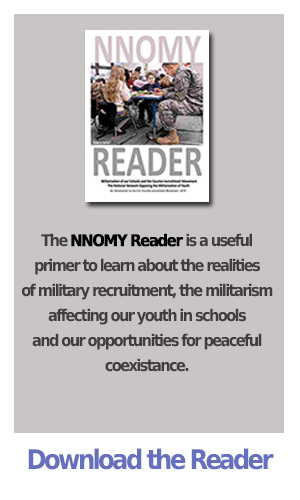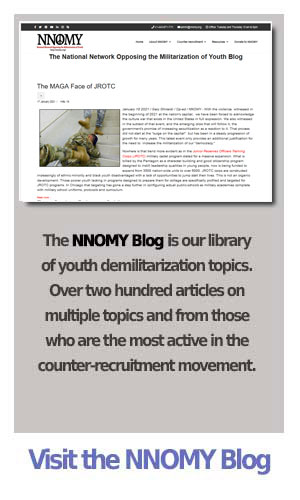Keep NNOMY aware of the latest news from your organization at This email address is being protected from spambots. You need JavaScript enabled to view it. so we can share it with the national network.
...........................................
counter-recruitment/ Online
"The UB School of Management SSCC (Strengthen Our Sense Of Community Committee) is working with AMillionThanks.org to send thank-you notes to members of our military (active, reserve and veterans). During the week of February 7 to 11, there will be a table set up in the Alfiero Center Atrium. Please stop down and write a brief note of appreciation and gratitude to send to our men and women serving our country. We have over 200 note cards to fill out, please spread the word!"
Six members of the committee signed this appeal.
At 10:11 a.m., I sent a bluntly worded e-mail to the Dean of the SOM:
"The SSCC sent me this strange request. I don't know whose idea this was, but it's a bad idea. The UB School of Management should not be involved in politics! This kind of thing supports the military, but such support is a political thing. A huge number of people object to using the military in such ventures as Iraq and Afghanistan, as well as many, many other places in the world. Therefore, such support coming from UB definitely takes a political position that is not neutral. The School has no business taking such a stance. I won't wash the School's dirty linen in public, but if this idea is not dropped, I surely will inform the Provost and the President of the University."
Washington, D.C.: Read more on the counter-recruitment Website
...........................................
Center on Conscience & War/ Washington, D.C.
On February 11, 2011, the Air Force notified Beverly Reader that it was discharging her as a conscientious objector. Beverly joined the Air Force in 2001, when she accepted a commission in the Air Force and began her medical studies at the Uniformed Services University of the Health Sciences, a military-run medical school in the Maryland suburbs of Washington, D.C. It was during a six-week medical school program in 2004 which brought her to the slums of South Africa that she began to make connections between the violence she witnessed there and the violence of war.
Washington, D.C.: Read more on the Center on Conscience & War Website
...........................................
Columbia River Fellowship for Peace/ Hood River
An opportunity has now opened up for CRFP to create an educational kiosk in the Columbia Gorge Scenic Area, at the Wyeth Campground (formerly Camp 21, a Conscientious Objector camp) near the city of Cascade Locks. The Forest Service has even invited CRFP to conduct “Campfire Talks,” about the Conscientious Objectors! These talks will not only tell the story of Camp 21, but of all the WWII COs who remained faithful to their convictions, and made long-lasting contributions to American society be it in their spiritual practices, arts, literature, forestry, academics, mental health care and especially human rights.
Hood River, Oregon: Read more on the CRFP Website
...........................................
Dutchess Peace/ New York
What is your opinion on the future of local peace and justice organizations in the Mid Hudson area? This survey was originally directed at members of Dutchess Peace (www.dutchesspeace.org), but we have decided to open it up to all. All responses are anonymous.
Poughkeepsie, New York: Take the poll on the Dutchess Peace Website
...........................................
Granny Peace Brigade/ Philadelphia
Our newest project: Bring the War $$ Home
Forty-six states are cutting their budgets. Fourteen to 100 cities could face bankruptcy this year. Local governments are closing libraries and schools, cutting vital safety net programs, selling off valuable public assets, and trying to balance their budgets on the backs of their employees. For more details see http://www.newprioritiesnetwork.org.
In line with this, we are working within the city of Philadelphia in coordination with other groups, to identify what our share of the war dollars could provide within our city. We are also circulating a City Council petition. Look for a copy of the petition and information on other actions, which will be posted here shortly!!
Philadelphia, Pennsylvania: Read more on the Granny Peace Brigade Philadelphia Website
...........................................
Massachusetts Peace Action/ Cambridge
Fund Our Communities, Not War!
Statewide Week of Action April 12-18, 2011
Massachusetts Peace Action is joining with the Eastern Massachusetts Campaign to Fund Our Communities – Cut Military Spending 25% and American Friends Service Committee to stage a Massachusetts-wide week of action April 12-18. We will be using the week to make our campaign visible. There IS money for our communities. The Pentagon has it! We want it back! Cut Military Spending, Not Us!
Cambridge , Massachusetts: Read more at the Massachusetts Peace Action Website
...........................................



 The warning, given to me 25 years ago, came at the moment Pat Robertson and other radio and televangelists began speaking about a new political religion that would direct its efforts at taking control of all institutions, including mainstream denominations and the government. Its stated goal was to use the United States to create a global, Christian empire. It was hard, at the time, to take such fantastic rhetoric seriously, especially given the buffoonish quality of those who expounded it. But Adams warned us against the blindness caused by intellectual snobbery. The Nazis, he said, were not going to return with swastikas and brown shirts. Their ideological inheritors had found a mask for fascism in the pages of the Bible. - Chris Hedges (From his article:
The warning, given to me 25 years ago, came at the moment Pat Robertson and other radio and televangelists began speaking about a new political religion that would direct its efforts at taking control of all institutions, including mainstream denominations and the government. Its stated goal was to use the United States to create a global, Christian empire. It was hard, at the time, to take such fantastic rhetoric seriously, especially given the buffoonish quality of those who expounded it. But Adams warned us against the blindness caused by intellectual snobbery. The Nazis, he said, were not going to return with swastikas and brown shirts. Their ideological inheritors had found a mask for fascism in the pages of the Bible. - Chris Hedges (From his article: 



 David Swanson is the author of the new book, Daybreak: Undoing the Imperial Presidency and Forming a More Perfect Union, by Seven Stories Press and of the introduction to The 35 Articles of Impeachment and the Case for Prosecuting George W. Bush by Dennis Kucinich. In addition to cofounding AfterDowningStreet.org, he is the Washington director of Democrats.com and sits on the boards of a number of progressive organizations in Washington, DC.
David Swanson is the author of the new book, Daybreak: Undoing the Imperial Presidency and Forming a More Perfect Union, by Seven Stories Press and of the introduction to The 35 Articles of Impeachment and the Case for Prosecuting George W. Bush by Dennis Kucinich. In addition to cofounding AfterDowningStreet.org, he is the Washington director of Democrats.com and sits on the boards of a number of progressive organizations in Washington, DC. Jorge Mariscal is the grandson of Mexican immigrants and the son of a U.S. Marine who fought in World War II. He served in the U.S. Army in Vietnam and currently teaches at the University of California, San Diego.
Jorge Mariscal is the grandson of Mexican immigrants and the son of a U.S. Marine who fought in World War II. He served in the U.S. Army in Vietnam and currently teaches at the University of California, San Diego. Matt Guynn plays the dual role of program director and coordinator for congregational organizing for On Earth Peace, building peace and nonviolence leadership within the 1000+ congregations of the Church of the Brethren across the United States and Puerto Rico. He previously served a co-coordinator of training for Christian Peacemaker Teams, serving as an unarmed accompanier with political refugees in Chiapas, Mexico, and offering or supporting trainings in the US and Mexico.
Matt Guynn plays the dual role of program director and coordinator for congregational organizing for On Earth Peace, building peace and nonviolence leadership within the 1000+ congregations of the Church of the Brethren across the United States and Puerto Rico. He previously served a co-coordinator of training for Christian Peacemaker Teams, serving as an unarmed accompanier with political refugees in Chiapas, Mexico, and offering or supporting trainings in the US and Mexico. Rick Jahnkow works for two San Diego-based anti-militarist organizations, the Project on Youth and Non-Military Opportunities and the Committee Opposed to Militarism and the Draft. He can be reached at:
Rick Jahnkow works for two San Diego-based anti-militarist organizations, the Project on Youth and Non-Military Opportunities and the Committee Opposed to Militarism and the Draft. He can be reached at:  Pat Elder was a co-founder of the
Pat Elder was a co-founder of the 
 Edward Hasbrouck grew up in Wellesley, Massachusetts, a suburb of Boston. He considers myself primarily a political activist. Hasbrouck began his resistance to the violence of illegitimate authority as an elected but nonvoting student representative to the local school board and as an activist for peace, disarmament, and students' rights. His first book was a handbook for high school students on their legal rights co-authored in the summer of 1977, between high school and college, as an intern for the student service bureau of the Massachusetts Department of Education. He majored in political science at the University of Chicago until leaving school to pursue direct involvement in political activism.
Edward Hasbrouck grew up in Wellesley, Massachusetts, a suburb of Boston. He considers myself primarily a political activist. Hasbrouck began his resistance to the violence of illegitimate authority as an elected but nonvoting student representative to the local school board and as an activist for peace, disarmament, and students' rights. His first book was a handbook for high school students on their legal rights co-authored in the summer of 1977, between high school and college, as an intern for the student service bureau of the Massachusetts Department of Education. He majored in political science at the University of Chicago until leaving school to pursue direct involvement in political activism.




